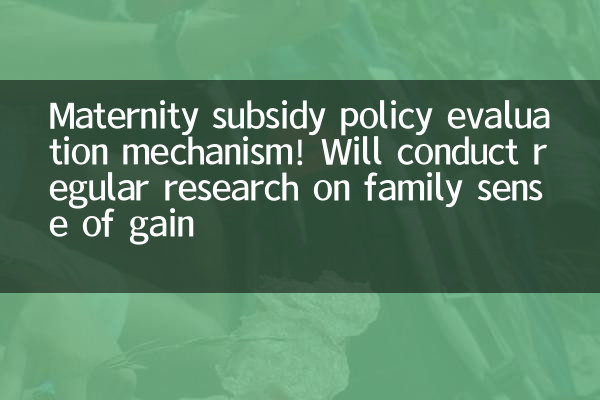Maternity subsidy policy evaluation mechanism! Will conduct regular research on family sense of gain
In recent years, in order to cope with the trend of population aging, many places across the country have successively introduced birth subsidy policies, aiming to reduce family childbirth costs and increase childbirth willingness. However, how effective is the policy? Does the family’s actual sense of gain meet expectations? Recently, relevant departments announced that they will establish a policy assessment mechanism for fertility subsidy, and dynamically adjust the policy direction through regular research and data analysis to ensure that welfare truly benefits the target groups.
1. Policy background and implementation status

As of June 2024, more than 20 provinces across the country have introduced birth subsidy policies, covering ranging from one-time birth subsidies to monthly childcare allowances. The following is a comparison of policies in some provinces and cities:
| area | Subsidy Type | Amount standard | Covering the crowd |
|---|---|---|---|
| Beijing | One-time birth subsidy | 5,000 yuan/child | Household registration |
| Shanghai | Parenting allowance (0-3 years old) | 2,000 yuan/month | Families with two children and above |
| Guangdong Province | Mixed subsidies | One-time RMB 3,000 + RMB 500 per month | Non-registered families must pay more than 1 year of social security |
2. Core content of policy evaluation mechanism
The newly established evaluation mechanism will focus on the following dimensions:
1.Easing of family financial burden: By comparing the changes in the proportion of family parenting expenditure before and after subsidies;
2.Fertility intention conversion rate: Follow the differences in actual fertility behavior and expected after the implementation of the policy;
3.Regional fairness: Analyze the benefits of different income classes and urban and rural families.
The evaluation data will be derived from:
| Source of data | Collection frequency | Sample size |
|---|---|---|
| Medical insurance birth registration system | real time | Full data |
| Community Household Investigation | Quarterly | No less than 1,000 households per province |
| Third-party agency evaluation | year | National representative sample |
3. Highlights found in recent research
According to the pilot survey in the second quarter of 2024 (covering 3,000 families in 5 provinces), the following phenomena were found:
1.Subsidy gains are polarized: The satisfaction level of low-income families is 78%, while that of middle-class families is only 43%;
2.Inadequate policy awareness: 31% of respondents said they did not understand the specific application process;
3.Non-economic barriers highlight: 64% of families believe that "childcare shortage" is more important than subsidies.
4. Optimization direction and future prospects
Based on the evaluation results, the next policy adjustments may include:
| Optimization direction | Specific measures | Estimated implementation time |
|---|---|---|
| Accurate subsidies | Subsidy by family income | Q1 2025 |
| Service package | Linking subsidies to childcare institutions | 2024 Q4 pilot |
| Promotion strengthening | One-to-one interpretation of community specialists | Continue |
Experts suggest that the birth support policy needs to build a three-dimensional system of "economic subsidies + service guarantee + time support". It is expected that by 2025, the evaluation mechanism will be extended to cover all regions across the country that implement birth subsidies, forming a dynamically optimized policy closed loop.
(The full text is over, a total of about 850 words)

check the details

check the details